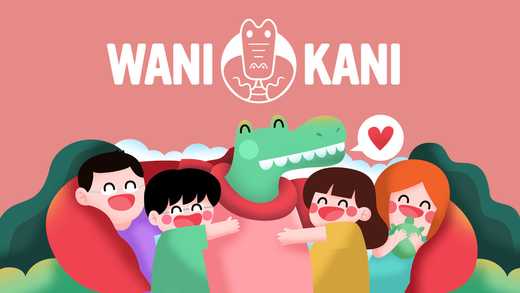WaniKani Review: Excellent (But Ugly) Kanji + Vocab Trainer
 Written byIchika Yamamoto
Written byIchika Yamamoto- Read time5 mins
- Comments4


- Unique and effective mnemonics method
- Spaced-repetition approach
- Inexpensive
- Free account restricted to 3 levels
- Overwhelming dashboard
- Dated interface
WaniKani's unique mnemonics are an effective way to acquire and retain large amounts of Japanese in a relatively short time. The SRS approach and periodic reviews ensure that what you've learned is not lost. The API is brilliant and well-documented. Overall, a decent trainer for Japanese vocabulary.
If you love Japanese culture or need to learn Japanese for any reason (e.g. reading manga comics) then you need quality resources to help you read kanji.
WaniKani is becoming an increasingly popular vocabulary trainer for Japanese learners.
Generally I recommend Rocket Japanese as a structured course that covers kanji in detail or Innovative Language’s JapanesePod101 along with italki for native speaker lessons. But WaniKani is another resource that’s caught my attention given its unique approach to mnemonics.
So in this review, I’ll share my thoughts on WaniKani and whether or not it’s worth the price.
Table of Contents:
What is WaniKani and who is it for?
WaniKani’s claim and purpose in their own words:
2,000 kanji. 6,000 vocabulary words. In just over a year.
That’s Jōyō kanji (常用漢字), which are taught in primary and secondary school in Japan and actually consist of 2,136 characters (WaniKani leaves out a few rare/unnecessary ones).
The claim of “just over a year” has been verified by numerous community members but requires an extremely dedicated, daily effort to achieve.
WaniKani is well-suited to absolute beginners learning to read for the first time, and progresses in levels (60 in total). These levels do not directly correspond to JLPT levels, however.
| Name | Levels |
|---|---|
| Pleasant | 1 - 10 |
| Painful | 11 - 20 |
| Death | 21 - 30 |
| Hell | 31 - 40 |
| Paradise | 41 - 50 |
| Reality | 51 - 60 |
You’ll be presented with what are called “radicals” - these are essentially building blocks for kanji. A mnemonic is given to help you remember their meaning, followed by kanji built from that radical, and as you click ‘next’, the lesson is marked complete.
Finally, you’re quizzed to make sure you’ve learned it.
The same is true of vocabulary which are made up of the kanji you’ve learned (see my Japanese onomatopoeia guide too).
Vocabulary also includes audio (both a female and male voice) which are high quality audio bites.
Successful acquisition of kanji and vocabulary is referred to by WaniKani as “burned” (as in “burned into your memory”). Once this is achieved, you won’t have to go over this item again.
Prior to this, you achieve various ‘stages’ (Apprentice → Guru → Master → Enlightened → Burned).
WaniKani does kanji and vocabulary extremely well
And doesn’t try to be anything else.
This is a great thing about WaniKani is that it’s a dedicated kanji and vocab trainer. It doesn’t try to incorporate other skills (e.g. listening comprehension) or add other half-baked features.
It just focuses on what it’s intended for and does it comprehensively.
Dated and overwhelming dashboard
Honestly, the single biggest issue I have with WaniKani is a superficial one - I just cannot stand the ugliness and overwhelmingness of the interface.
From a UX (user experience) perspective, it’s just not nice to use.
You log in and it’s not immediately clear what you should do next. There are prompts to start your first lesson (a popup modal), but it’s just not clear how it all works or where to go.
Plus, for those of you who may be new to Japanese, you may end up wondering what all this Japanese stuff on the opening screen actually means (i.e. what’s a radical?)
I feel that if WaniKani improved the interface and simplified everything, it’d be even more popular than it already is.
Pricing: Is WaniKani free?
WaniKani offers a free account up until you reach Level 4.
At that point, you have the following options to subscribe:
- $9 a month
- $89 a year (2 months free)
- $299 lifetime/one-time charge
I find this pricing reasonable and in line with most other online subscription for language courses/products.
WaniKani vs Anki vs Memrise
Anki is the all-time best, 100% free and open source alternative to sites like WaniKani.
This is an SRS flashcard program that runs on all operating systems where you can create your own decks of vocabulary, phrases and even kanji.
The problem of course, is that you have to create your own decks or find the right decks to import. The good news is that there appear to ways to export WaniKani data to Anki decks (check the community forum for questions on this).
Another alternative to both WaniKani and Anki is Memrise.
This is a free online collection of community decks that is beautifully designed and gamified, but with a premium paid option. See this comparison between Memrise and Duolingo for more info.
WaniKani API
One of my absolute favorite features of WaniKani is the exposed and very well-documented API.
This won’t interest most people since it’s really just for developers, but I’ll try to explain what it means for you:
WaniKani have enabled developers to connect to their server programmatically so that they can retrieve things like stats, and much more. This means that a developer can produce an app, website or enhancement with added functionality (i.e. a nicer interface) which pulls that data from WaniKani.
You can see the massive list of third party apps and sites created by developers using WaniKani’s API.
Summary: Is WaniKani worth it?
I think WaniKani is extremely comprehensive in what it does.
It’s essentially a vocabulary and literacy trainer for Japanese kanji, with an enormous amount of attention to detail.
If you’re looking for a Japanese course or app to learn Japanese then look elsewhere. That’s not what WaniKani is designed for.
WaniKani will not teach you speaking or listening comprehension.
My biggest issue with WaniKani however, is the dated and overwhelming interface, and the bland presentation of the mnemomics (contrasted with the simplicity of Memrise for example).
If you can look past the UI deficiencies, it’s an otherwise great product for Japanese at a perfectly reasonable price point.
Create a free account before laying any money down and use it for the first 3 levels at no risk.
Also see this list of Japanese resources for other alternatives.
Used WaniKani before? What are your thoughts?
Comment below!
 Grab the link to this article
Grab the link to this article